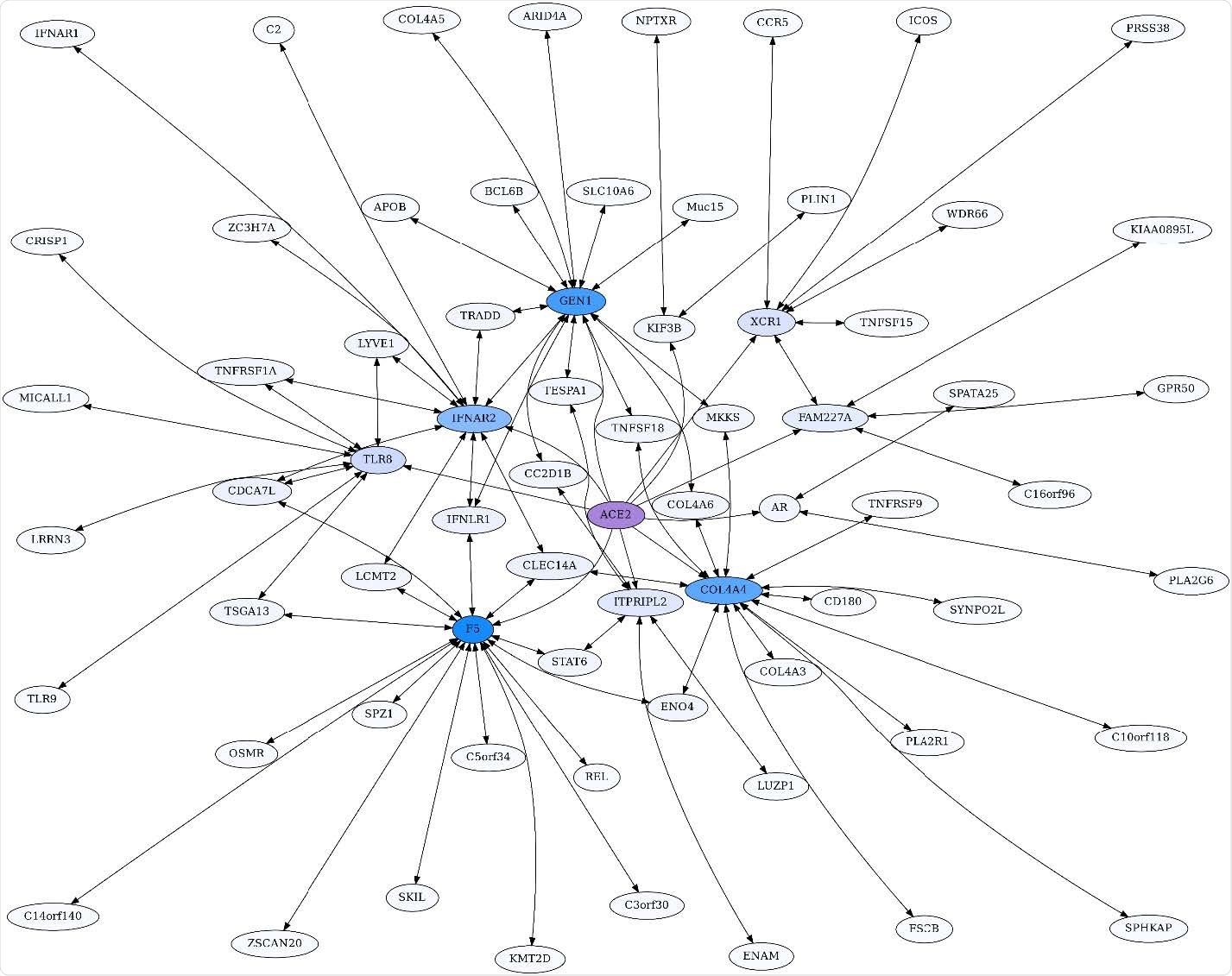The novel coronavirus severe acute respiratory syndrome coronavirus 2 (SARS-CoV-2) has caused severe morbidity and mortality across the world. Other than flu-like symptoms of respiratory disease, SARS-CoV-2 infection can also cause systemic manifestations, leading to a wide range of pathologies, including thrombosis and microvascular injury and stroke, vascular system disruption, gastrointestinal complications, ocular and dermatological symptoms, cardiac and kidney pathologies, neurological manifestations, male infertility, and a Kawasaki-like blood and heart disorder in children.
A severe and often fatal immune response called a “cytokine storm” can occur following SARS-CoV-2 infection. Some patients suffer from a range of complications several months after testing negative for SARS-CoV-2, and this is called ‘Long Haul’ or ‘Long’ COVID-19. The causes behind this phenomenon are not well understood.
.jpg)
The human ACE2 receptor and its role in SARS-CoV-2 entry into host cells
The angiotensin-converting enzyme 2 (ACE2), the primary receptor for entry of SARS-CoV-2 into human cells, also plays a role in blood pressure regulation and vasodilation by the renin-angiotensin system, and digestion of protein in the gut. The binding of SARS-CoV-2 to ACE2 leads to a downregulation in ACE2 function, which may be associated with systemic damage.
“Angiotensin-converting enzyme 2 (ACE2) is of obvious interest because it is a primary receptor for SARS-CoV-2 entry into human cells.”
Elevated soluble ACE2 levels have been found in severely ill COVID-19 patients, explaining the reduced expression of membrane-bound ACE2. According to a recent study, sACE2 may have a role in SARS-CoV-2 entry via other receptors.

A novel approach – evolutionary inference – to understanding protein-ACE2 s interactions
A better understanding of what kind of proteins ACE2 interacts with can shed light on disease manifestations and potential treatment avenues. Researchers from the US attempted a new approach to predict candidate proteins interacting with ACE2. They used evolutionary inference to identify a group of mammalian proteins that “coevolve” along with ACE2. This study is published on the bioRxiv* preprint server.
The novel approach is called evolutionary rate correlation (ERC), and it detects proteins with highly correlated evolutionary rates in mammalian evolution. These proteins can be good candidates for biological interactions with ACE2.
“Overall, the underlying concept behind the evolutionary rate coevolution concept (also called evolutionary rate covariance or evolutionary rate coevolution) is that coevolving proteins will show correlated rates of change across evolution and that this reflects functional interactions.”
The approach has revealed many fundamental ACE2-protein interactions which may be relevant to COVID-19 pathologies. While some proteins reported to be linked to severe COVID-19 are currently not known to interact with ACE2 directly, some other novel proteins interacting with ACE2 may be relevant to COVID-19.
ACE2 has strong connections to coagulation pathway proteins relevant to COVID-19 pathologies
With the help of reciprocal rankings of protein ERCs, the researchers identified strongly interconnected protein networks associated with ACE2 that are relevant to COVID-19 pathologies. The findings show that ACE2 has strong connections to coagulation pathway proteins, including coagulation factor V and fibrinogen components FGG, FGB, and FGA.
The fibrinogen components may mediate through ACE2 connections to clusterin, which removes misfolded extracellular proteins, and GPR141, functions of which are relatively not clear.
SARS-CoV-2 disrupts novel protein-ACE2 interactions contributing to COVID-19 pathologies
Moreover, ACE2 has links to proteins part of cytokine signaling and immune response such as IFNAR2, XCR1, and TLR8, and to the androgen receptor. The ERC pre-screening approach has also clarified potential functions for some previously uncharacterized proteins and additional functions for some already well-characterized proteins.
The study also discussed validation approaches for ACE2 interacting proteins predicted by ERC. The authors propose that SARS-CoV-2 infection disrupts novel protein interactions of ACE2, which contributes to the wide range of COVID-19 pathologies.
“Finally, if evidence mounts that ERCs can be informative in predicting protein interactions, the approach can be applied more broadly as an additional tool for detecting protein interaction networks involved in biological processes and disease.”
*Important Notice
bioRxiv publishes preliminary scientific reports that are not peer-reviewed and, therefore, should not be regarded as conclusive, guide clinical practice/health-related behavior, or treated as established information.
- Evolutionary Inference Predicts Novel ACE2 Protein Interactions Relevant to COVID-19 Pathologies Austin A. Varela, Sammy Cheng, John H. Werren bioRxiv 2021.05.24.445517; doi: https://doi.org/10.1101/2021.05.24.445517, https://www.biorxiv.org/content/10.1101/2021.05.24.445517v1
Posted in: Medical Research News | Medical Condition News | Disease/Infection News
Tags: ACE2, Androgen, Angiotensin, Angiotensin-Converting Enzyme 2, Blood, Blood Pressure, Children, Coronavirus, Coronavirus Disease COVID-19, Cytokine, Digestion, Enzyme, Evolution, Flu, Heart, Immune Response, Infertility, Kidney, Male Infertility, Membrane, Mortality, Protein, Receptor, Renin, Respiratory, Respiratory Disease, SARS, SARS-CoV-2, Severe Acute Respiratory, Severe Acute Respiratory Syndrome, Stroke, Syndrome, Thrombosis, Vascular

Written by
Susha Cheriyedath
Susha has a Bachelor of Science (B.Sc.) degree in Chemistry and Master of Science (M.Sc) degree in Biochemistry from the University of Calicut, India. She always had a keen interest in medical and health science. As part of her masters degree, she specialized in Biochemistry, with an emphasis on Microbiology, Physiology, Biotechnology, and Nutrition. In her spare time, she loves to cook up a storm in the kitchen with her super-messy baking experiments.
Source: Read Full Article





